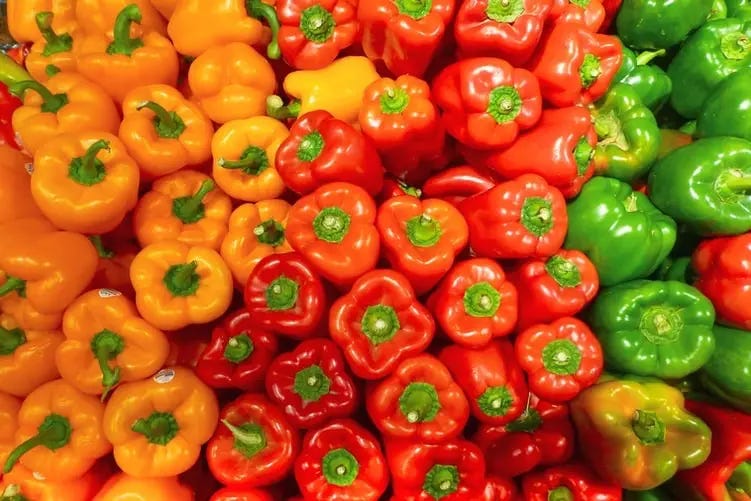An easy way to check if you’re eating a balanced meal is to look at the colours on your plate. You should have at least three.
Colours don't just make food look good. They are there because specific nutrients have specific colours. The deeper the colour of a food, the more of that kind of nutrient it has. The most vibrantly coloured fruits and vegetables are the richest in vitamins, minerals, fibre and antioxidants.
Fruits and vegetables come in a rainbow of colours. They get their colour from phytochemicals – natural bioactive compounds which give them their eye-catching colours.
We’ve all heard the advice to ‘eat your greens’. Now scientists are telling us that it’s just as important to eat your reds, oranges, yellows, blues and purples too.
Even within one fruit or vegetable, there may be tremendous colour variation. The goal of “eating the rainbow” is to experiment with new fruits and vegetables, as well as tasting new varieties. For instance, cauliflowers come in white, orange, purple, green and yellow. Carrots come in orange, white, yellow and purple. Peppers also come in a wide array of colours. Additionally, there are lesser known choices such as the purple varieties of lettuce, basil, and string beans, amongst others.
Diversity is also key to a healthy microbiome. If you only ate bananas every day you would end up with a gut full of bacteria loving bananas. Eating a varied and diverse array of fruit and veg is likely to lead to an equally diverse and healthy microbiome.
The following is a summary of the most common colours, their corresponding benefits – and the relevant fruits and vegetables within each colour group:
RED
Eat More …
Tomatoes, beets, cranberries, pomegranates, red apples, red peppers, strawberries, red onions, and raspberries.
Benefits
Red-coloured fruits and vegetables tend to be rich in anti-cancer nutrients and antioxidants. Studies have found that tomatoes can help decrease one’s risk of prostate cancer. Strawberries help lower the risk of oesophageal cancer, and cranberries have the same effect on breast, colon, and lung cancer.
They can improve heart health and memory function.
They are packed with vitamins A, C and Potassium.
ORANGE/YELLOW
Eat More …
Oranges, carrots, yellow and orange peppers, bananas, sweet potatoes, tangerines, peaches, pineapples, mangoes, grapefruit, lemons, corn, butternut squash and apricots.
Benefits
The beta-carotenes in orange foods can help prevent cancers of the lung, oesophagus, and stomach – as well as reducing the risk of heart disease.
A serving of one of the orange vegetables listed above, such as sweet potato, provides potassium which helps to lower blood pressure, vitamin C to boost the immune system, and fibre to help with weight management.
These coloured fruit and veg are also beneficial for eye, skin, and bone health.
GREEN
Eat More …
Broccoli, brussels sprouts, celery, asparagus, avocados, bok choy, cucumbers, green beans, green cabbage, green grapes, green peppers, kale, kiwis, leeks, peas, lettuce, spinach, watercress, green herbs and courgettes.
Benefits
Greens contain the chemicals sulforaphane and isocyanate which help ward off cancer by inhibiting carcinogens.
The deeper and darker greens like spinach and kale are extremely nutritious. They contain significant amounts of calcium, potassium and vitamins A and K.
Greens are crucial for blood, bone, and eye health. They can also help strengthen the immune system and regulate cholesterol levels.
Green foods provide the body with folic acid – an essential nutrient for pregnant women as it helps the body create healthy new cells.
BLUE/PURPLE
Eat More …
Blueberries, blackberries, aubergines, cherries, red grapes, plums and prunes.
Benefits
Blue and purple foods protect our bodies and minds by reducing oxidation. All berries are an integral component of the MIND Diet, which focuses on keeping your brain sharp as you age.
The blue fruit, like blueberries, contains anthocyanins, which are another phytonutrient – often labelled as superfood. These help to reduce the risk of macular degeneration, cancer and stroke.
WHITE
Eat More …
Cauliflower, garlic, mushrooms, onions, parsnips, shallots, ginger and white potatoes.
Benefits
These support immune, lymph, and heart health.
The onion family (including garlic) contains allicin, which has antitumour properties.
Certain mushrooms have shown potential to protect against cancer.
Recipe ~ Roasted Rainbow Vegetables
You can use any vegetables you like in this dish. You can also replace the soy sauce with mustard/balsamic vinegar. Similarly, you can choose your favourite herbs to give extra flavour.
Serves 4 as a side dish
Ingredients
1 red pepper, chopped
1 yellow pepper, chopped
2 carrots, sliced
½ head broccoli, cut into florets
1 small courgette, chopped
1 red onion, chopped
2 tablespoons extra virgin olive oil
2 tablespoons soy sauce
Salt and pepper
A handful of parsley (or thyme)
Method
1. Preheat the oven to 200°C or 400°F.
2. Arrange the peppers, carrots, broccoli, courgette and red onion on a baking sheet. Brush the olive oil and soy sauce over the vegetables and toss gently to coat; season with salt and pepper.
3. Roast until the vegetables are tender and starting to turn toasty around the edges (20 to 25 minutes). Sprinkle with parsley or any herb you like.
Notes
1. I like to use a small brush to coat the vegetables. It gives an even spread of the oil mixture with little excess.
2. If you want to prepare this meal as a main course you could add chicken to the dish at the start (see above). Conveniently, the chicken pieces also cook in about 25 minutes.
Enjoy!
—
Disclaimer
This blog is for informational purposes only and should not be construed as medical advice. If you have any questions about your own nutrition plan, please consult your doctor.












